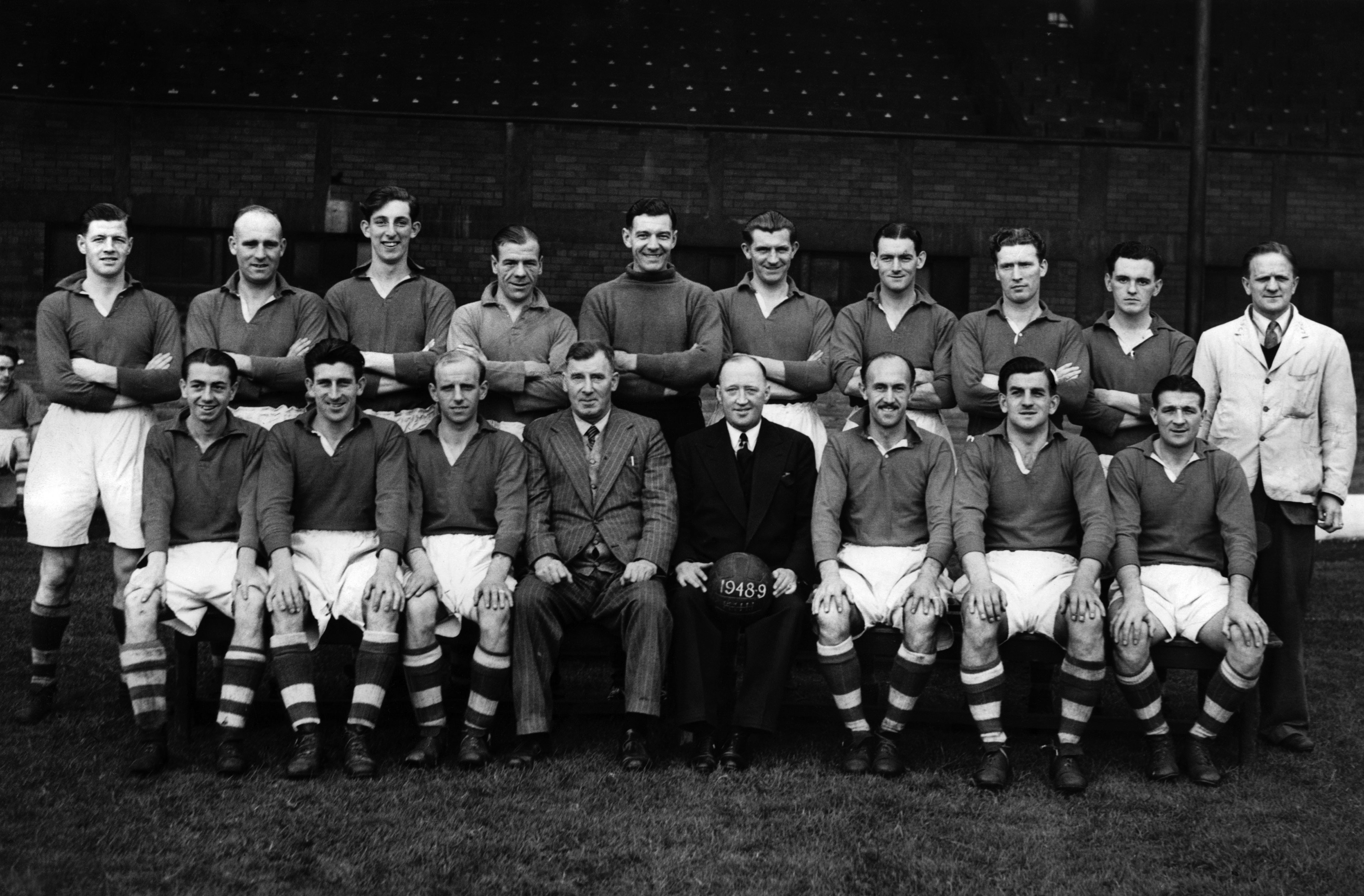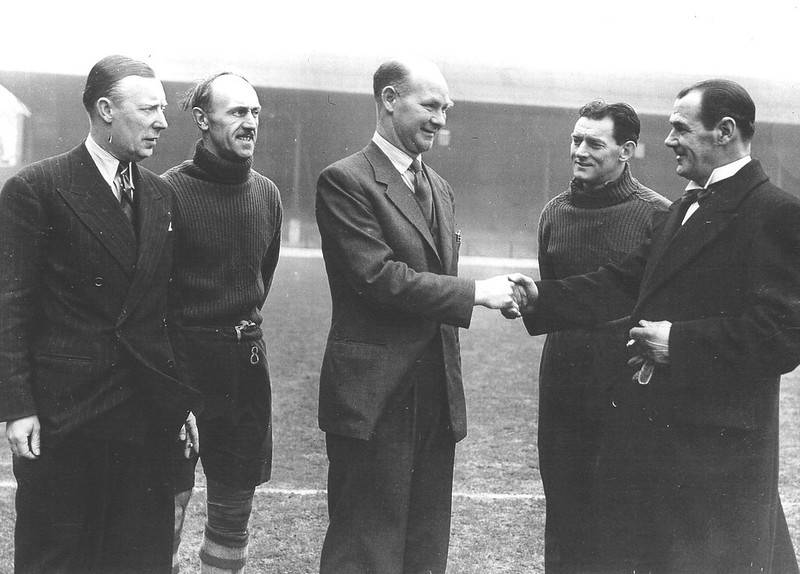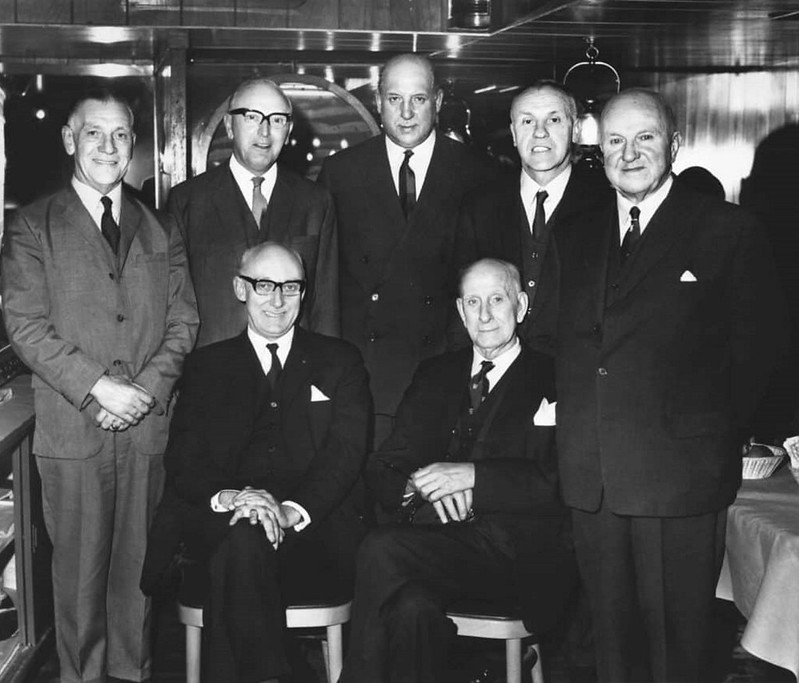Articles
LFC in decline 1947-1959
Timing and possible causes
Back in the 1930s, LFC’s final league positions had been 9, 10, 14, 18, 7, 19, 18, 11, 11 (average 13th). Following the success of 1946/47, we ended 11, 12, 8, 9, and 11 (average 10th) during the remainder of George Kay’s management. With these adjoining, albeit unspectacular, league positions on either side of 1946/47, Liverpool had clearly been punching above its weight, especially with Jack (‘hat trick of hat tricks’) Balmer and newcomer Albert Stubbins who, between them, contributed 56 of the 96 goals scored that season. A solution to the problem of explaining the decline, therefore, appears to be not in the 1940s, but in the next decade, especially between Kay’s retirement in 1951 and relegation three seasons later. We could pinpoint a time even more narrowly in the 1952/53 season when we were top of Division 1 until the second week in October, having won seven out of the eleven matches played, but subsequently won only seven of the remaining thirty-two, drawing six, and losing nineteen. October 1952, however, does not reveal a cause, merely a tipping point along a line of protracted problems. Despite the occasional win in the next, fatal, season (Burnley 4-0), Aston Villa (6-1), and Blackpool (5-2), LFC was in the lower half of the table from the end of August until hitting rock bottom on 19 December, the final blow, from which we did not get up, being delivered at Old Trafford. Symbolically, full-back Eddie Spicer was stretchered off, having broken the same leg as last time, after a clash with our own Phil Taylor and keeper Underwood.

Liverpool FC in 1948/49: Back row left to right. Eddie Spicer, Ray Lambert, Laurie Hughes, Bill Shepherd, Cyril Sidlow, Bill Jones, Phil Taylor, Willie Fagan, Ken Brierley, Albert Shelley (trainer).
Front row. Jimmy Payne, Billy Watkinson, Doug McAvoy, George Kay (manager), Stanley Ronald Williams (chairman), Jack Balmer (captain), Cyril Done, Bob Paisley.
Until 1949/50, goal difference had been in the black. That balance tipped in 1950/51, George Kay’s final season, when the number of goals scored since the exceptional season 1946/47 remained fairly buoyant until relegation. Furthermore, ‘goals for’ remained at an acceptable figure despite the loss of fan favourite forwards. Jack Balmer left the club in May 1952, but he had not scored in his only four appearances that season. Inside-left Willie Fagan also left in that summer, and proved hard to replace, but scored only three in his final season. The last appearance of striker Albert Stubbins was on 3 January 1953, though his contract lasted another nine months. However, he had not scored, or even appeared, during those successful first eleven games of 1952/53, having been involved in a car crash early in the season; and he had scored only six goals in 1950/51 and five in 1951/52. The fact that these forwards were ‘missing’ was not the cause of our fall into Division 2. In any case, much of the ‘slack’ was taken up by Billy Liddell (66 goals 1949/50 to 1952/63, thus starting the taunt of LFC being ‘Liddellpool’).
| Season | Goals scored | Goals against | Goal diff. | Games |
|---|---|---|---|---|
| 1946/47 | 96 (2) | 56 (1.17) | +40 | 48 |
| 1947/48 | 69 (1.44) |
65 (1.35) |
+4 | 48 |
| 1948/49 | 61 (1.33) | 48 (1.04) | +13 | 46 |
| 1949/50 | 75 (1.53) | 60 (1.22) | +15 | 49 |
| 1950/51 | 54 (1.26) | 62 (1.44) | -8 | 43 |
| 1951/52 | 60 (1.33) | 64 (1.42) | -4 | 45 |
| 1952/53 | 24 (2.18) | 15 (1.36) | +9 | 11* |
| 1952/53 | 37 (1.16) | 68 (2.12) | -31 | 32** |
| 1952/53 | 61 (1.42) | 83 (1.93) | -22 | 43*** |
| 1953/54 | 67 (1.58) | 98 (2.28) | -31 | 43**** |
*To October only
** From October
*** Full season
**** Relegation
The ‘Echo’s’ critic of Liverpool’s 5-1 loss to Arsenal on 15 November, 1952, suggested that ‘the Anfielders are far more likely to slide down the table [from the then 7th] than to improve their present position. Fighting spirit cannot make up for their shortcomings’ needing ‘greater physical attributes in attack, and a return to the old-time solidity in defence’. One of those shortcomings was literal – the 5’ 5” average height of the forward line (without Liddell) causing more than one journalist to describe them as ‘midget’, and therefore bound to have difficulty against physically stronger opponents. Yet the ‘goals scored’ tally remained respectable right down to relegation 18 months later.
A glance down the ‘goals against’ column, however, lays bare the major problem - the goals conceded rose by some thirty per cent. Goalkeeper Charlie Ashcroft had played only occasionally since the war, succeeding Cyril Sidlow in that fateful season 1951/52. With full-back Ray Lambert to guard him, the pair appeared successfully together during those first eleven games of 1952/53 with results comparable to those of earlier years. That 5-1 home drubbing by Arsenal, after a few other poor results, lost Ashcroft his place between the posts, to be usually replaced by Russell Crossley who kept out only 0.1 goals fewer per game as they shared the misery of the remainder of the season, with a number of different full backs - Gerhardi, Jones, Lambert, Moran, Parr, Spicer. Crossley then left for Shrewsbury Town.

Don Welsh (in the middle) with players Jack Balmer on the left and Phil Taylor on the right, greeted by chairman George Richards.
Management
The invitation to the popular Don Welsh, following George Kay’s retirement, must rank as one of LFC’s worst decisions of the post-war era. To be fair to him, he had not even applied for the manager’s job, and the Liverpool board seems to have based the decision on Welsh’s popularity as a guest player during the war, as well as his willingness to do as he was told! It could hardly have been based on his experience as a manager, as his only spell was a few modest years with Brighton in the 3rd Division (South). He was never in a position to demand the right to choose the team, or have a say in recruitment, a sine qua non for Bill Shankly when he had turned down the job at that time. The goal difference evidence has suggested that the decline had started in George Kay’s final season. Neither the board nor this new manager was in a position to halt it, especially as they seemed to remain loyal to players past their best.
The squad size may be related to LFC’s league position. Until 1949/50, about 27 players were used, falling for two seasons to 23, then back to 27. In the critical years, we played 29, and 31 as relegation threatened and finally happened. After the fatal season of 1953/54, twelve of the squad did not survive to reappear for LFC in Division 2, but I think few fell into the category of putting self before club. The threat of relegation was evident before Christmas 1953 when we reached the bottom of the league, and did not rise even one position thereafter.
Four stalwarts who signed before the war now reached the end of their playing careers – Bill Jones (went as player-manager to Ellesmere Port Town), Bob Paisley, Eddie Spicer and Phil Taylor. Immediate post-war signing Kevin Baron had scored 19 goals during his last three seasons, but now Liverpool’s loss was third-division (South)’s gain. A small fire-sale was designed to help LFC counter the reduced income. Sammy Smith was sold to Bangor, Joe Maloney and Russell Crossley to Shrewsbury Town, Jack Smith to Torquay United. The final three were Albert Childs (who was an amateur anyway) transferred to Bishop Auckland, Harold Jones had a free transfer to Rhyl, and Arthur Rowley to Wrexham.
None of the above ‘jumped ship’, in the sense of staying in Division 1 with another club while their former colleagues sank into Division 2. I think that, of the players, only Billy Liddell could have done so, and he, of course, remained loyal. In the second division, significantly smaller size squads were used, as low as 21 in 1956/57.
Attendances
One of the dangers of falling to Division 2 was a possible reduction in the number of spectators. It is an important issue, both as an indication of the degree of faithful support for the club, and as measure of the revenue available to buy new players capable of getting LFC back to where they belonged. Post-war attendances stood at an average home gate of 43,842 in the 1946/47 season, when we topped the First Division. This figure had fallen to 39,961 when we finished 11th in 1951/52, and remained fairly steady (39,933 and 40,980) in the next two seasons – remarkably buoyant while spectators had to watch the club fall to 16th and were then relegated at bottom of the table 22nd. Included in these figures were attendances at the popular FA Cup games, dwarfed by the 61,905 fans who watched the fourth round against Wolves at Anfield on 2 February 1952. Bad luck of the draw gave us no home Cup games boost in 1952/52, or in 1953/54 when we were relegated.
The funeral, symbolized by the death of former manager George Kay the day before, drew only 22,000 to the last home match of the season (beating a then-bogey club Middlesbrough), but for most games, home fans had remained loyal. Even two days earlier, there had been 41,340 at Anfield.
Into the abyss
Until 1987/88, there were 22 clubs in the top Division, two of which were relegated at the end of each season, making thirty clubs in all from 1946/47 to 1960/61 inclusive. How did Liverpool fare compared with the twenty-nine other clubs which had been relegated to Division 2? Not very well. We were in Division 2 for eight seasons (1954/55 to 1961/62 inclusive). Seventeen of the other twenty-nine spent less time in waiting, with Aston Villa, Manchester City, and Sheffield Wednesday bouncing back after only one season away (Sheffield three times in the fifteen years!) Even Everton had only three seasons in Division 2, ironically promoted as Liverpool was relegated. (Not a time for a harmonious family life with divided loyalties!). Another nine clubs, however, did not come back within ten years of being relegated.
During the spell in the Second Division, gates were as follows, with before and after figures for comparison.
| Season | Avg. league gate | Cup inc. | Season |
|---|---|---|---|
| 1953/54 | 40,980 | - | Relegated |
| 1954/55 | 36,150 | 36,889 | |
| 1955/56 | 37,324 |
39,296 |
|
| 1956/57 | 35,211 | - | |
| 1957/58 | 38,476 | 39,495 | |
| 1958/59 | 36,653 | - | |
| 1959/60 | 30,279 | 31,859 | |
| 1960/61 | 29,603 | 29,731* | |
| 1961/62 | 39,227 | 40,313 | Promoted |
| 1962/63 | 45,393 | 46,995 | Division 1 |
*Includes 10,502 and 14,036 for the first League Cup games.
In summary, during the eight seasons in Division 2 attendances were down by between 5,000 and 10,000, representing perhaps 10 to 20 per cent of the club’s gross income. Board members, since maligned by Bill Shankly’s record of his struggles, were understandably nervous about spending beyond their now more limited means. The Shankly effect was not immediate, and it was only in his second full season that a road to financial recovery could be seen (with hindsight) to have started. The old dilemma (‘We can’t afford to buy him’ versus ‘We can’t afford not to buy him’) then played out in LFC’s favour – but where DID we get the money to buy, e.g. St John and Yeats? We’ve read the story of Eric Sawyer’s rescue package which enabled Shankly to buy such players, but what was the source?

Liverpool's board in 1970 with the all-important Eric Sawyer second on the left in the top row. Line-up: Cecil Hill, Eric Sawyer, Sidney Reakes, Bill Shankly, Tom Smith, Eric Roberts and TV Williams
Goal difference indicates a continued decline in LFC’s fortunes in the second division (including Doug Rudham letting in 9 against Birmingham on 11 December 1954) with no keeper consistently good enough to keep his place. Ashcroft, then only 29, was belatedly asked to leave in 1955 with Rudham and Dave Underwood already sharing duties, and newly-capped Scottish international Tommy Younger to be first choice for the 1956/57 season. The effect on the ‘goals against’ column was immediate, falling by about one third. Bert Slater, Jim Furnell and finally Tommy Lawrence brought more stability to the position under Shankly.
| Season | Goals scored | Goals against | Goal diff. | Games |
|---|---|---|---|---|
| 1954/55 | 98 (2.13) | 99* (2.13) | -1 | 46 |
| 1955/56 | 93 (1.97) |
70 (1.49) |
+23 | 47 |
| 1956/57 | 82 (1.91) | 56 (1.30) | +26 | 43 |
| 1957/58 | 88 (1.87) | 60 (1.28) | +28 | 47 |
| 1958/59 | 88 (2.05) | 64 (1.49) | +24 | 43 |
| 1959/60 | 93 (2.11) | 70 (1.59) | +23 | 44 |
| 1960/61 | 97 (2.06) | 67 (1.43) | +30 | 47 |
| 1961/62 | 105 (2.23) | 48 (1.02) | +57 | 47 |
*Including 9 by Birmingham, 11 December
Conclusion
Responsibility for the decline into Division 2 must be ascribed to the Liverpool board of directors, first for the appointment of Don Welsh, and subsequently for their parsimonious approach to replacing players to whom they stayed misappropriately loyal. On the field, there can be little doubt that the defence let LFC down, and that, without Billy Liddell, the fall would have been sooner and more prolonged. Clearly, inadequate defending must have shown the need for getting replacements, especially for goalkeepers, but Ashcroft was allowed to continue for another two years.
There are a few signs of recovery before the arrival of Shankly. Our Division 2 league positions were 11th in 1954/55, 3rd in 19565/56, 3rd in 1956/57, 4th in 1957/58, and 3rd in 1958/59, figures which alone were enough make the new manager believe that it should not take long to take LFC up again. Attendances were good for the division. Phil Taylor had steadied the ship at personal cost to his health, and at the end of October 1958 he was brave enough to drop the ageing Billy Liddell, and face the music from the Kop for several months. New players had been appointed (Wheeler and Younger in 1956, Byrne and Harrower a year later) though how far these can be ascribed to Taylor personally is a moot point. Squad size rose from the low points of 1956/57 and 1958/59 until Shankly’s new broom, sweeping away six and introducing ten new faces, (including Ian Callaghan and Roger Hunt).


